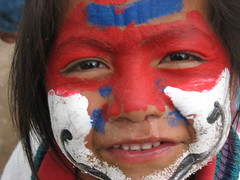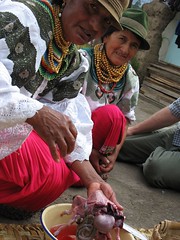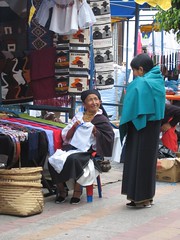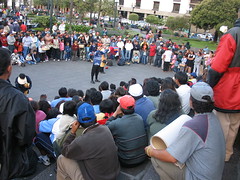Yambiro
For the second time this trip our whole group jumped in the back of a cattle truck for the fifteen minute ride up the hill from Otavalo to the Indigenous village of Yambiro. There are around 175 families living in Yambiro, farming and tending their animals.
Last week, we arrived in Yambiro in the early afternoon. We hopped off our cattle truck and after a bit of milling and the arrival of the village president, we gathered the village members into the half built village assembly hall and clinic. In the dusty air of the newly plastered walls, 80-ish people gathered to listen to a series of public health presentations we had prepared in our meagre Spanish. First came dental hygiene, then sanitation, water chlorination, nutrition and female reproduction. With great care and interest, the village president then translated each presentation into Quichua for the older generations who spoke no Spanish.
After the bulk of the presentations, we then set up a make shift medical clinic which involved jerry rigging a small corner of privacy in the large hall fluttering with people. Half sheet, half straw mat, the divider served to create a space where we would see four to six people at a time, often families with multiple generations, and as time passed, increasing numbers of interested family members peering over the divider.
Guided by Doctor Victor, a physician from Jambi Huasi, a clinic in Otavalo that offers both western and indigenous medicine, Kyle, Vanessa, Julie and I manned our stethoscopes and went to work to see the forty plus women and children that filled the hall. Quickly, I had to learn a new set of associations. A stomach ache most often meant parasitic infection, likely worms. A headache was likely to be untreated vision problems, and we looked at the conjunctiva of the children’s eye to detect anemia that was likely a result of malnutrition. Most everyone had stomach aches or headaches, or a combination of the two.
We had a makeshift pharmacy as well, distributing donations we had gathered prior to the trip: prenatal and children’s vitamins, ibuprofen, and antibiotics. We would have to return with antihelminthics another day. In all, not a lot to actually tackle the health problems of the community. And while I love working with patients one on one, it became utterly clear that all of our solutions were merely a stay of execution and that seeing patients was a drop in the bucket compared to an effective public health campaign.
Thus, in our second hop out of the cattle truck, we set about treating the animals that are intimately intertwined in the lives of the people of Yambiro. Now, I can tell you right off the bat that I know very little about injecting animals. What I did discover, however, was that the people of Yambiro has a very special way with their animals. Instead of holding down the pigs while they screamed and do they ever scream, the locals just scratch their bellies. The pigs love it and promptly tip over in a semi dreamlike bliss, making injections easy. In all we dewormed over 70 pigs, cows, and sheep.
Last week, we arrived in Yambiro in the early afternoon. We hopped off our cattle truck and after a bit of milling and the arrival of the village president, we gathered the village members into the half built village assembly hall and clinic. In the dusty air of the newly plastered walls, 80-ish people gathered to listen to a series of public health presentations we had prepared in our meagre Spanish. First came dental hygiene, then sanitation, water chlorination, nutrition and female reproduction. With great care and interest, the village president then translated each presentation into Quichua for the older generations who spoke no Spanish.
After the bulk of the presentations, we then set up a make shift medical clinic which involved jerry rigging a small corner of privacy in the large hall fluttering with people. Half sheet, half straw mat, the divider served to create a space where we would see four to six people at a time, often families with multiple generations, and as time passed, increasing numbers of interested family members peering over the divider.
Guided by Doctor Victor, a physician from Jambi Huasi, a clinic in Otavalo that offers both western and indigenous medicine, Kyle, Vanessa, Julie and I manned our stethoscopes and went to work to see the forty plus women and children that filled the hall. Quickly, I had to learn a new set of associations. A stomach ache most often meant parasitic infection, likely worms. A headache was likely to be untreated vision problems, and we looked at the conjunctiva of the children’s eye to detect anemia that was likely a result of malnutrition. Most everyone had stomach aches or headaches, or a combination of the two.
We had a makeshift pharmacy as well, distributing donations we had gathered prior to the trip: prenatal and children’s vitamins, ibuprofen, and antibiotics. We would have to return with antihelminthics another day. In all, not a lot to actually tackle the health problems of the community. And while I love working with patients one on one, it became utterly clear that all of our solutions were merely a stay of execution and that seeing patients was a drop in the bucket compared to an effective public health campaign.
Thus, in our second hop out of the cattle truck, we set about treating the animals that are intimately intertwined in the lives of the people of Yambiro. Now, I can tell you right off the bat that I know very little about injecting animals. What I did discover, however, was that the people of Yambiro has a very special way with their animals. Instead of holding down the pigs while they screamed and do they ever scream, the locals just scratch their bellies. The pigs love it and promptly tip over in a semi dreamlike bliss, making injections easy. In all we dewormed over 70 pigs, cows, and sheep.





